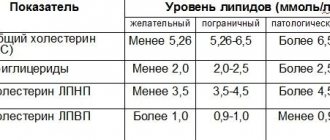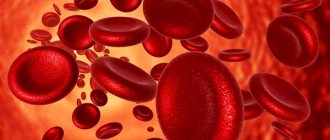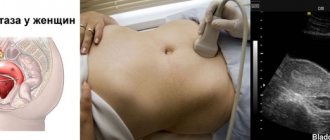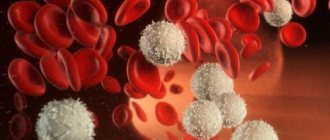Atherosclerosis
Stroke
COVID-19
14135 April 13
IMPORTANT!
The information in this section cannot be used for self-diagnosis and self-treatment.
In case of pain or other exacerbation of the disease, diagnostic tests should be prescribed only by the attending physician. To make a diagnosis and properly prescribe treatment, you should contact your doctor. We remind you that independent interpretation of the results is unacceptable, the information below is for reference only
D-dimers are fragments of the fibrin molecule formed during its breakdown. They received this name because they contain two connecting D-fragments of the fibrinogen protein.
D-dimer: indications for use, rules for preparing for the test, interpretation of results and normal indicators.
Indications for the purpose of the study
Damage to the vascular wall triggers a cascade of physiological reactions in the body aimed at preventing bleeding. The result of these processes is the formation of a blood clot consisting of blood cells and fibrin protein. Normally, factors that promote blood clotting and factors that prevent its development are in balance.
Formation of a blood clot, or blood clot, that blocks bleeding
As a result of the work of the fibrinolytic system, fibrin is split into smaller fragments, so the clot does not spread from the site of vessel damage throughout the entire vascular bed. In this case, various fibrin degradation products of different molecular weights are formed, among which there are D-dimers.
Illustration “Fibrin Degradation” Caption Fragments of the fibrin molecule formed during its breakdown
The level of D-dimer in the blood reflects both the formation of fibrin and its dissolution.
An increase in plasma D-dimer levels is observed approximately 2 hours after the onset of thrombosis.
D-dimer is metabolized in the kidneys, its half-life with preserved renal function is approximately 6-8 hours. Malfunctions of the fibrinolytic system can lead to increased formation of blood clots.
An increased level of D-dimer in the blood indicates actively occurring thrombus formation processes, but does not allow one to judge the localization of the thrombus, therefore, determining the level of D-dimer in the blood plasma is used to exclude thrombosis of any location.
Patients with high D-dimer levels require instrumental examination to confirm or rule out thrombosis.
Patients with initially high D-dimer concentrations have approximately 3.5 times the risk of developing venous thromboembolic complications (VTE) than patients with low concentrations.
VTEC includes:
- deep vein thrombosis of the lower extremities;
- saphenous vein thrombosis;
- pulmonary embolism (PE).
At risk of developing VTEC are:
- aged people;
- overweight people;
- pregnant women;
- patients with cardiovascular diseases (CVD);
- post-stroke patients in the intensive care unit (ICU);
- patients after extensive surgery, trauma, burns;
- patients with cancer;
- septic patients.
D-dimer may increase in the absence of venous thromboembolic complications. The reasons may be:
- fibrinolytic therapy (therapy aimed at dissolving blood clots) in the previous 7 days before the study;
- myocardial infarction;
- atherosclerosis;
- sepsis, severe infections;
- cirrhosis of the liver;
The D-dimer content increases significantly during pregnancy and reaches a maximum in the third trimester. This process has physiological significance and is aimed at reducing blood loss during childbirth.
High concentrations of D-dimer can be detected in women with pregnancy complications (preeclampsia, preeclampsia), in pregnant women with diabetes mellitus and kidney disease. Assessing the level of D-dimer in patients with a history of complicated pregnancy allows us to identify risk groups for whom antithrombotic prophylaxis is mandatory. If there is a genetic predisposition to thrombosis, an increase in D-dimer levels in the first trimester of pregnancy may indicate a high risk of thrombotic and obstetric complications.
DIC syndrome (disseminated intravascular coagulation syndrome) is characteristic of sepsis. The appearance of blood clots in the microvascular bed leads to disruption of the functioning of organs and systems and the development of multiple organ failure. Increased D-dimer levels are found in almost 95% of patients with sepsis.
Normally, D-dimer levels increase with age due to decreased renal clearance of plasma proteins, increased fibrinogen levels, and/or the presence of underlying and systemic diseases.
Thus, the determination of D-dimer is used for diagnosis:
- thrombotic conditions (deep vein thrombosis, often complicated by pulmonary embolism);
- DIC syndrome;
- complications during pregnancy;
- post-Covid syndrome.
In addition, the study is necessary to monitor anticoagulant therapy (determining its duration, effectiveness and dose of prescribed drugs).
How to lower d-dimer
There are a number of medications - anticoagulants that block the formation of a blood clot. Their main effect is to disrupt the formation of fibrin. And if there is no fibrin, then there are no breakdown products, including d-dimer. With anticoagulant treatment, d-dimer levels gradually decrease. The main side effect of anticoagulants is that they can cause bleeding.
The most important and interesting news about infertility treatment and IVF is now in our Telegram channel @probirka_forum Join us!
dimer, hemostasiogram
Increased values: reasons
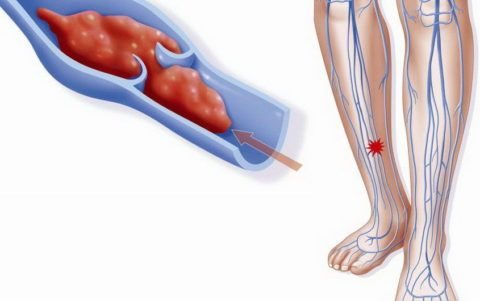
Increased D-dimer in deep vein thrombosis
A high concentration of the protein fragment indicates a constant process of dissolving blood clots, that is, the struggle of the circulatory system with the resulting blood clots.
Causes:
- deep vein thrombosis (DVT);
- pulmonary embolism (PE);
- disseminated intravascular coagulation (DIC syndrome);
- pathologies of the cardiovascular system;
- neoplasms;
- thrombolytic treatment.
The increase in the concentration of the protein fragment can be affected by various inflammatory phenomena, pathological processes in the liver, surgical interventions, injuries, the period of gestation, as well as the advanced age of the patient. Therefore, a diagnosis cannot be made based on a high D-dimer test value alone. An increased result is a reason to conduct additional studies to identify possible pathological thrombus formation.
D-dimer is elevated, but everything else is normal - what does this mean?
This situation often occurs during normal operation of the hemostatic system. An increase in D-dimer in the blood does not necessarily indicate a tendency to intensive thrombus formation.
A similar analysis result is typical for elderly patients, with normal pregnancy, and extensive hematomas.
An increase in the fibrinolysis product with other normal coagulogram parameters occurs when:
- nodular periarthritis - chronic progressive inflammation of the walls of small and medium-sized blood vessels;
- systemic lupus erythematosus - an autoimmune diffuse pathology characterized by complex degeneration of connective tissues;
- rheumatoid arthritis – a joint disease of the erosive-destructive type;
- abuse of tobacco products;
- large blood loss due to injury or surgery.
This analysis result serves as a reason for in-depth and expanded diagnostics using laboratory hardware.
Increasing values
- The presence of arterial and venous blood clots;
- Acute inflammatory or infectious process;
- Sepsis (severe infection of the body);
- Liver and kidney diseases;
- Oncological processes;
- Extensive hematomas (for example, as a result of a fall, compression, etc.).
Physiological increase in D-dimer concentration:
- normal pregnancy (moderate increase from the 1st trimester);
- pathological pregnancy (critical level of indicator);
- old age (from 80 years);
- recent surgery;
- thrombolytic treatment.
Indications for analysis
The D-dimer test is carried out as part of a coagulogram, which involves drawing blood from a vein.
The main indications for analysis are the following:
- Age over 80 years;
- General diagnosis of thrombotic conditions;
- Diagnosis of related diseases: DIC syndrome;
- deep vein thrombosis;
- pulmonary thromboembolism;
- cerebrovascular accidents (stroke);
- heart attack, etc.;
- threat of miscarriage;
The following symptoms may indicate the need for research:
Symptoms of deep vein thrombosis:
- swelling, pain and numbness in the area of one or two lower extremities, increasing with physical activity;
- pallor or cyanosis of the skin in the area of thrombosis.
Symptoms of pulmonary embolism
- sudden shortness of breath,
- difficulty breathing,
- hemoptysis,
- chest compression;
- sharp pain in the chest.
During pregnancy:
- headaches, toxicosis, weakness, swelling, high blood pressure and protein in the urine in pregnant women;
And other symptoms:
- tachycardia, arrhythmia and pain in the heart;
- bleeding of unknown etiology;
- severe pain in muscles and abdomen;
- urinary disorders (reduced urination), etc.
- cyanosis of the skin.
What should the normal indicator be?
The normal level of D-dimer in blood plasma is 250 ng/ml. this indicator confirms that the patient is not at risk of thrombosis. In pregnant women, this figure can reach 1000 ng/ml or more, i.e. grow 3–4 times.
Normal D-dimer levels in pregnant women:
- up to 450–500 ng/ml in the 1st trimester;
- up to 900–920 ng/ml in the 2nd trimester;
- up to 1450–1500 ng/ml in the 3rd trimester.
If a pregnant woman, on the contrary, has a low level, she is urgently referred to a hematologist, who will prescribe medications. A decrease in dedimer during pregnancy is a sign of long-standing problems with blood clotting that arose long before pregnancy. With good treatment, childbirth proceeds normally.
Preparing for analysis
- It is preferable to donate blood for D-dimer in the morning on an empty stomach (the last meal - 8-10 hours before the test); before the test you can drink still water.
- It is also permissible to donate blood during the day, but not earlier than 4 hours after a light meal.
- The day before taking blood, it is necessary to exclude increased psycho-emotional and physical stress, and alcohol intake.
- Do not smoke 30 minutes before the test, incl. e-Sigs.
Sources:
- Data from the independent laboratory Invitro and Helix
- Jeffrey I. Weitz; James C. Fredenburgh; John W. Eikelboom "A Test in Context: D-dimer" Journal of the American College of Cardiology 2017;70(19):2411-2420.
Read more about blood clotting indicators
- Coagulogram: main indicators
- Fibrinogen in the blood
- APTT
- Prothrombin
- Thrombin time
- D-dimer
- Lupus anticoagulant
- Antithrombin III
- Plasminogen
- Protein C
- Protein S free
- Coagulogram during pregnancy
D-dimer - what kind of analysis is it, why is it prescribed?
Increased permeability and fragility of vessel walls is accompanied by internal bleeding. Fibrin, a high molecular weight, non-globular protein, is used to inhibit this dangerous process.
It is involved in the mechanism of formation of blood clots that clog microscopic wall holes. Exceeding the norm of non-globular protein plays a negative role in the hemostasis system, as it increases the risk of thrombosis.
A special functional enzyme, plasmin, is responsible for regulating this process and maintaining hematological balance. Its main task is to break down excess fibrin.
As a result of the biochemical interaction of plasmin with a high-molecular non-globular protein, a D-dimer is formed. The intensity of fibrinolysis is influenced by some physiological factors.
D-dimer (the norm in women by age is directly proportional to the rate of breakdown of non-globular protein) is the main marker of thrombosis, allowing the pathological condition to be diagnosed at an early stage.
The volume of protein breakdown product depends on:
- size and quantity of dissolved blood clots;
- taking anticoagulants;
- drug therapy using thrombolytic drugs.




